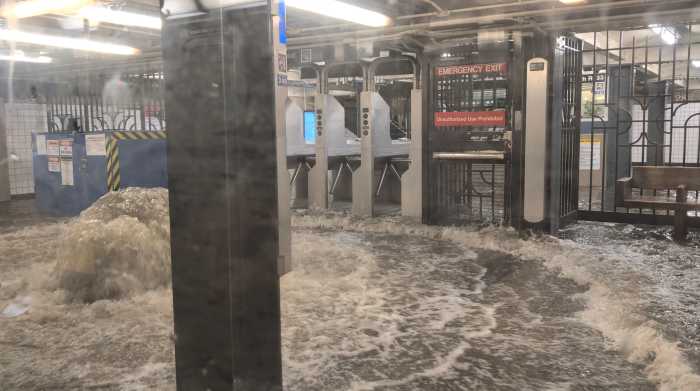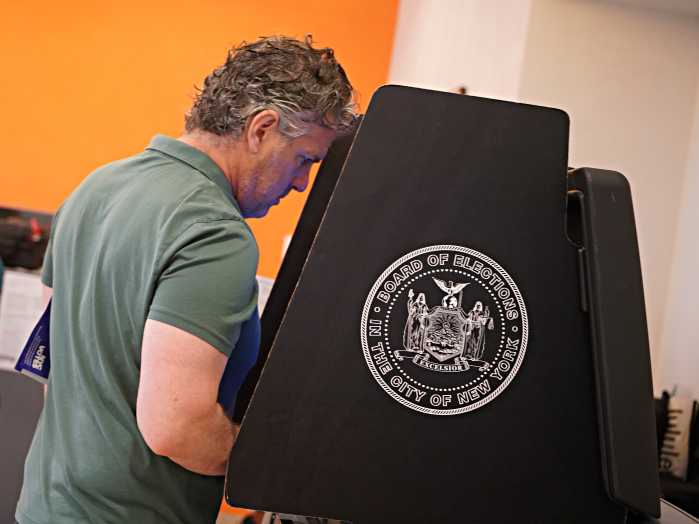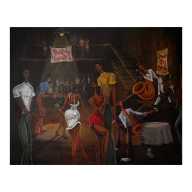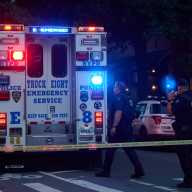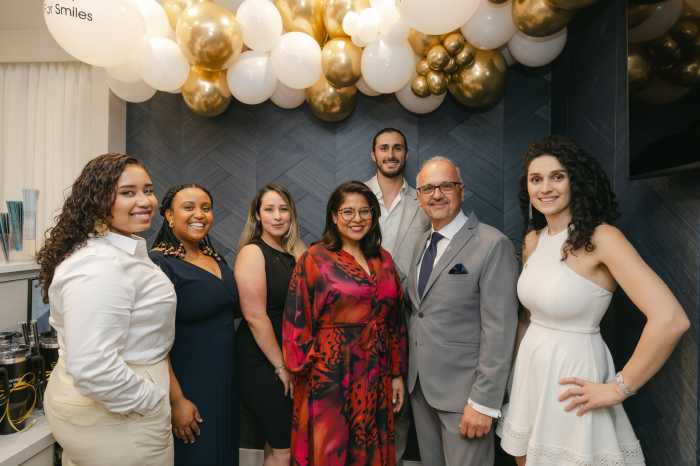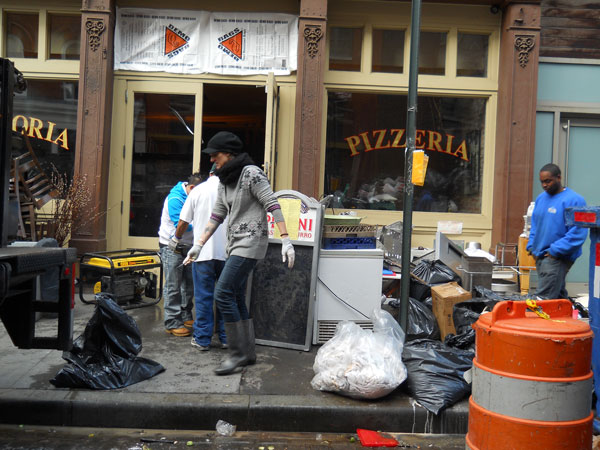
BY ALINE REYNOLDS & KAITLYN MEADE | Battery Park City has received most of the city’s media attention following Hurricane Sandy. But, of all the neighborhoods in Lower Manhattan, the South Street Seaport suffered the most damage, having experienced an eight-foot water surge that destroyed the interiors of many area businesses.
Front Street business owners, whose restaurants and shops took the hardest blow, were emptying out their storefronts a couple of blocks away from the East River in the days and hours after the storm. While some are optimistic about re-opening in the coming weeks, most of the entrepreneurs are leaving future business plans up in the air until they have a clearer picture of the extent of damage and expenses.
Fernando Dallorso, the owner of Stella Manhattan Bistro on Front Street, lost nearly all the furniture and equipment inside his seven-year-old restaurant to water damage.
“We don’t foresee any opening in the next month or so,” he said, distraught. “Ninety-nine percent of the stuff is going to be thrown away. Everything is useless.”
Keg 229 and Bin 220, both on Front Street, also saw extensive losses, according to co-owner Calli Lerner. “It’s devastating — I don’t even know where to begin. These are our babies, these businesses,” she said. “We have to throw everything away…the tables, the chairs, the refrigeration that might have gotten damaged from the water, the computer systems and most of the technology.”
Lerner continued, “We’re hoping that FEMA helps us out, we’re hoping that insurance comes through…and we can start to rebuild.” The Federal Emergency Management Agency has provided generators, supplies and medical centers to the city in advance of the storm.
On the bright side, the destruction caused by the storm is an opportunity for the businesses on the block to collectively start over, she and other business owners noted. “We’re going to rebuild Front Street together, like how we did in the beginning…we all started together,” Lerner said of the historic buildings renovated five years ago.
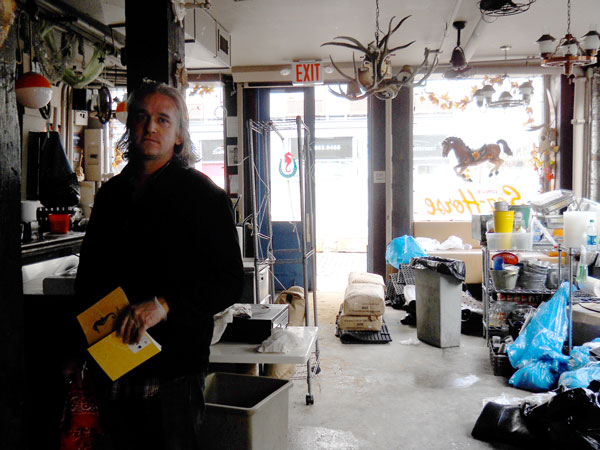
Jeremy Holin, owner of Jeremy’s Ale House across the street, insisted that he wouldn’t let the storm shutter his 40-year-old business — even though interior renovations have cost him at least a week’s worth of business. “We’ll reopen it if it takes my last penny,” he said.
Stephen Smith, co-owner of the Cowgirl Sea-Horse, a restaurant perched on the corner of Frankfort and Front Streets, will have to gut and renovate most of his business’s interior and chuck $20,000 worth of food that was stored in its West Village location. “Everything [exposed to the flooding] needs to be destroyed, so we’re trying to do an inventory,” he said.
With no paycheck for days or weeks on end, Smith and several other area employees might have to register for unemployment subsidies as a last resort. “Half of those people aren’t going to be able to return, ‘cause they can’t survive however many weeks it’s going to be,” said Smith. “They’re going to have to find another job.”
As for the restaurant’s future — which employs 35 people — while Smith and the other owners are soliciting help from FEMA and elsewhere in hopes of re-opening, the restaurant’s future is currently up in the air. “We’re keeping our fingers crossed and hoping for the best,” said Smith. “We have a lot of money, a lot of time and a lot of effort invested in the place.”
Miraculously, the vessels docked at South Street Seaport Museum, located at 12 Fulton St., fared better during the hurricane than many of the neighborhood’s landlocked businesses. All seven ships made it through the storm with little to no damage.
In a press release issued by the maritime museum on Wednesday, president Susan Henshaw Jones said, “At the South Street Seaport Museum, all the vessels rode out Hurricane Sandy and the surge with very little difficulty, thanks to days of preparation and a right-on-the-money calculation about the amount of slack needed for the lines securing the Peking, the Wavertree and the Ambrose to Pier 15 and Pier 16.”
Captain Jonathan Boulware, the museum’s waterfront director, and his crew logged about 350 hours of work over the weekend to properly secure the ships before the storm reached the area. The work paid off, as the lines endured a direct hit from the storm surge on Pier 16.
The historic vessels moored at the Seaport include the Ambrose, the Wavertree, the Peking, the W.O. Decker, as well as a car float, the barge Progress and the Pioneer’s dock. Two of the Seaport Museum’s vessels, the schooner Pioneer and the Fredonia-model fishing schooner, the Lettie G. Howard, were not in Lower Manhattan during the storm because they were previously moved elsewhere for repairs.
Dedicated staff volunteers also made storm preparations at the museum’s Fulton Street space throughout the weekend, sandbagging and taping the windows. A few staff members stayed there overnight during Sandy despite the evacuation notice for the entire neighborhood.
Several areas in the building sustained damage from about five feet of flooding on the first floor, including the café, the admissions desk and the gift shop. The exhibitions and collections, however, escaped harm. The museum will remained closed as long as it’s without power.
While expressing gratitude for its volunteers, Henshaw Jones was dismayed by the water damage in the museum’s interior. “It’s not just that there was five feet of filthy, oil-laced surge in our lobby, wiping out the systems that run the escalator, the elevators and the heating and air conditioning,” said Henshaw Jones. “It’s the loss of revenue that we had been building so diligently.”
“Even if we are able to open next week, we face outside a huge loss in passersby and tourists. To date, there are only gawkers.”
Many of the buildings in the South Street Seaport historic district also sustained heavy flood damage. The museum reported the letterpresses and type at Bowne & Co., Stationers, the museum’s old-fashioned printing house, were damaged by two and a half feet of floodwater.




